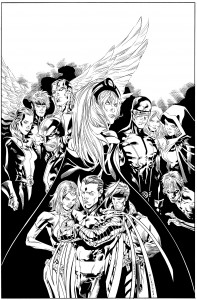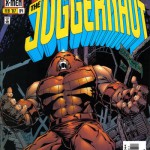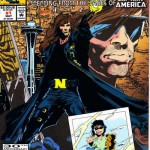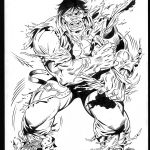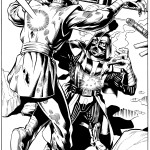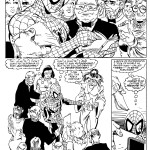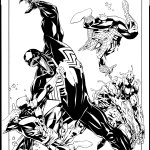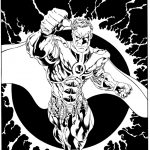Back in 1985 Mark McKenna got his first real break when he was asked to ink a page from the Indiana Jones series. At the time Mark was working in the Marvel system as one of the now legendary Romita’s Raiders, an apprenticeship program that had been set up to offer aspiring artists the chance to learn the craft of comic book art from none other than John Romita. For most of the early 1980s then Editor-In-Chief Jim Shooter had been actively seeking out new talent and the result was a reported 20,000 submissions from artists, writers, colourists, editors, letterers and more from one announcement alone. John Romita was serving as Marvel’s art director and in his quest for assistance with mundane tasks such as art corrections and fill ins, the pairing of new talent with Romita’s skills and knowledge seemed a total no-brainer, so a number of artists were selected and enrolled in the program. All contacted accepted except for one – Mark McKenna. Mark declined the offer but, due to Romita’s persistence, finally accepted. For the next two years Mark worked alongside John Romita, learning not only how to work in the system, but how to work the system. “Let them know you’re alive,” Romita told Mark, “show your face.” It was this advice that Mark took on board the most. “I have tried doing that but with not much success,” says Mark today, “I was always an artist that had jobs find me, as I have gotten older, I have had a difficult time soliciting to get work.” This is the common problem that all artists, especially inkers, face in today’s high tech world.
But back in 1985 Mark showed that he would never be content to be anyone other than himself. He was given the Indian Jones page and realised that this would be a good break. Fellow artist, Keith Williams, had been in the Romita’s Raiders for a mere six month before he was plucked out to be an assistant editor, others, such as Don Hillsman, Tom Morgan, and James Fry were very settled in and yet others, such as Scott Williams, were on their way to being household names in the comic book world. For Mark the turning point was that, when given the page, he was instructed to ink it in the same way that then regular inker, Danny Bulanadi would. “It was a chance to show my stuff,” said Mark in 1986. “Thing is, I had to ink like Danny Bulanadi, and I don’t want to ink like Danny Bulanadi. I’d rather ink like Mark McKenna!” Still, Mark did the job and learnt another lesson – give the editor what they want and they’ll remember you. It was the perfect way for Mark to make valued contacts within the industry and, upon ‘graduating’ from the Romita’s Raiders system, Mark was on his way.
 Over the next decade or two, Mark worked solidly and steadily. He moved from job to job, inking the pages put before him. Describing himself as patient and disciplined, he knew exactly what needed to be done in order to sustain a lengthy career. “I know what I’m doing,” he says now, “I’m not flashy and I’ve been told I’m ‘always good’ by some.” Being ‘always good’ is the key to explaining his longevity. In an industry where some inkers have flourished and make an impact, only to vanish as quickly as they entered, being ‘always good’ without being overpowering equates quality and substance over temperament. Find a person who says that Mark McKenna is a handful to work with and you’ll find a person who hasn’t worked with him all that closely. From the class of 1985, Mark is more than likely the last man standing who is still working in comic books today on any kind of a basis.
Over the next decade or two, Mark worked solidly and steadily. He moved from job to job, inking the pages put before him. Describing himself as patient and disciplined, he knew exactly what needed to be done in order to sustain a lengthy career. “I know what I’m doing,” he says now, “I’m not flashy and I’ve been told I’m ‘always good’ by some.” Being ‘always good’ is the key to explaining his longevity. In an industry where some inkers have flourished and make an impact, only to vanish as quickly as they entered, being ‘always good’ without being overpowering equates quality and substance over temperament. Find a person who says that Mark McKenna is a handful to work with and you’ll find a person who hasn’t worked with him all that closely. From the class of 1985, Mark is more than likely the last man standing who is still working in comic books today on any kind of a basis.
During his career Mark has inked some of the biggest and best names going. He forged a close alliance with penciler Mike McKone and the two of them have created some amazing work, albeit far too little. In another time the team of McKone and McKenna would be as famous as Byrne and Austin or Lee and Williams, but, alas, it is not. More is the shame. Still, no man can boast that they have inked the likes of Todd McFarlane, Shawn McManus, Barry Kitson, Keith Giffen, Sal Velluto, Jackson Guice, Tom Raney, Jim Calafiore, J.H. Williams III, and Travis Charest – in fact it’s probably quicker to list the artists that he hasn’t inked. At his own estimate Mark has inked over 7,000 pages, but that estimate might be lowballing it. He doesn’t do work for awards, “I was nominated for a CBG award back when I was working on Doom patrol in 1989, serious fans did that book had,” he says, but the only awards he’s ever won was for, “Coach of the year for my kids soccer team and I won a 1st place softball award in college intramural league.” Now Mark McKenna can add to his trophy case an Inkwell Joe Sinnott Hall Of Fame, an award that is reserved for legends. Mark is now breathing the same rarefied air as Joe Sinnott himself, Wally Wood, Terry Austin, Klaus Janson, Kevin Nowlan, Dick Giordano and Al Williamson. “I have a running joke with a buddy artist of mine who makes his living in the weapons simulation center at West Point,” Mark commented, “he always introduces me as ‘legendary’… Really? So I’m up to about 15 fan/friends calling me legendary and of course, I’m not a legendary anything. I’m just a hard-working slob.”
Mark might not be on the same level as John Romita, but, for a lot of us, he is a legend in his field. Here’s to a well deserved winner of the 2012 Hall Of Fame – Mark McKenna!
—Daniel Best – Senior Contributor, Resident Writer

